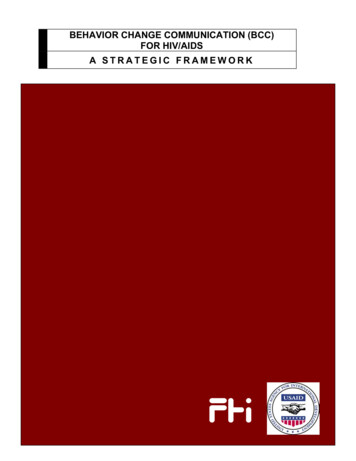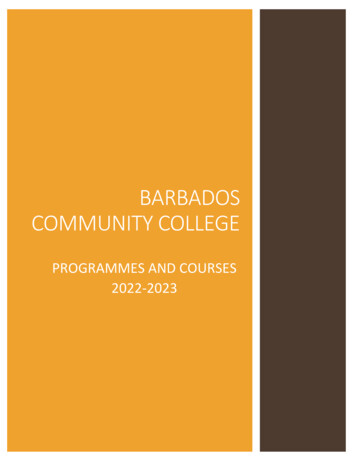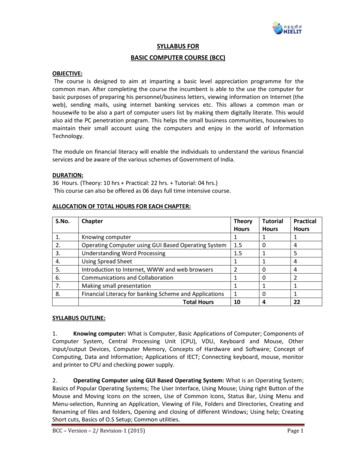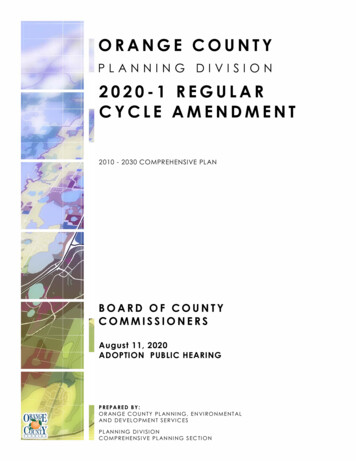
Transcription
BEHAVIOR CHANGE COMMUNICATION (BCC)FOR HIV/AIDSA STRATEGIC FRAMEWORK
This work was supported by the United States Agency for International Development (USAID) as part of FamilyHealth International’s Implementing AIDS Prevention and Care (IMPACT) Project (Cooperative AgreementHRN-A-00-97-00017-00) and does not necessarily reflect the views of USAID or FHI.FHI implements the USAID IMPACT Project in partnership with the Institute of Tropical Medicine ManagementSciences for Health Population Services International Program for Appropriate Technology in Health and theUniversity of North Carolina at Chapel Hill September 2002Family Health InternationalInstitute for HIV/AIDS2101 Wilson Boulevard, Suite 700Arlington, VA 22201 U.S.A.
BEHAVIOR CHANGE COMMUNICATION (BCC)FOR HIV/AIDSA STRATEGIC FRAMEWORKGLOSSARY3I.INTRODUCTION5II.THE ROLE OF BEHAVIOR CHANGE COMMUNICATION5III.THE PROCESS OF BEHAVIOR CHANGE: A FRAMEWORKFOR BCC DESIGN7IV.BCC GOALS8V.GUIDING PRINCIPLES8VI.FHI’s APPROACH9VII.BCC STRATEGY DEVELOPMENT AND PLANNINGState program goalsInvolve stakeholdersIdentify target populationsConduct formative BCC assessmentsSegment target populationsDefine behavior change objectivesDesign BCC strategy and monitoring and evaluation (M&E) planDevelop communication productsPre-testingImplement and monitorEvaluationFeedback and redesign9VIII.CHALLENGES19IX.MANAGEMENT OF BCC AND BUDGET19X.CAPACITY-BUILDING20XI.LINKAGES AND PARTNERSHIPS20XII.CONCLUSION21XIII.FURTHER READING211
2
GLOSSARYBEHAVIOR CHANGE INTERVENTION (BCI): A combination of activities/interventions tailored tothe needs of a specific group and developed with that group to help reduce risk behaviors and vulnerability toHIV by creating an enabling environment for individual and collective change.BEHAVIOR CHANGE COMMUNICATION (BCC): An interactive process with communities (asintegrated with an overall program) to develop tailored messages and approaches using a variety ofcommunication channels to develop positive behaviors; promote and sustain individual, community andsocietal behavior change; and maintain appropriate behaviors.FORMATIVE BCC ASSESSMENT: Research conducted before the start of a project to help staffestablish target population profiles to be used in developing messages.GATEKEEPER: A person outside a target audience who has both influence and control over access to thataudience.GOAL: The hoped-for result of a program or project.INTRAVENOUS DRUG USER (IDU): A person who injects drugs (and thereby raises his or her risk ofHIV infection).INFORMATION, EDUCATION AND COMMUNICATION (IEC): Development of communicationstrategies and support materials, based on formative research and targeted at influencing behaviors amongspecific groups.OBJECTIVE: A specific, measurable and time-bound result.OPINION LEADER: A person who has great influence over members of a target audience.PLHA: Person/s living with HIV/AIDS.STRATEGIC PLANNING: A disciplined effort to generate fundamental decisions and actions that willshape and guide the direction of a project or program. Strategic planning is flexible, often iterative and longrange, covering a period of three to five years. It includes setting the project’s/program’s goals, strategies andobjectives.STRATEGY: A coordinated and comprehensive plan for guiding multiple actions or activities that are aimedat achieving a project’s goal and objectives.STAKEHOLDER: A person or group with an interest in the outcome of an intervention.SEX WORKER (SW): A person who sells sex in exchange for money, commodities, or services.TARGET POPULATION: A group within a population who share similar characteristics and behaviors,and upon whom BCC activities are focused.TRADITIONAL MEDIA: Channels of communication that are usually culture- or community-specific.3
4
I. INTRODUCTIONBehavior change communication (BCC) is an interactive process with communities (as integrated with anoverall program) to develop tailored messages and approaches using a variety of communication channels todevelop positive behaviors; promote and sustain individual, community and societal behavior change; andmaintain appropriate behaviors.In the context of the AIDS epidemic, BCC is an essential part of a comprehensive program that includesboth services (medical, social, psychological and spiritual) and commodities (e.g., condoms, needles andsyringes). Before individuals and communities can reduce their level of risk or change their behaviors, theymust first understand basic facts about HIV and AIDS, adopt key attitudes, learn a set of skills and be givenaccess to appropriate products and services. They must also perceive their environment as supportingbehavior change and the maintenance of safe behaviors, as well as supportive of seeking appropriatetreatment for prevention, care and support.In most parts of the world, HIV is primarily a sexually transmitted infection (STI). Development of asupportive environment requires national and community-wide discussion of relationships, sex and sexuality,risk, risk settings, risk behaviors and cultural practices that may increase the likelihood of HIV transmission.A supportive environment is also one that deals, at the national and community levels, with stigma, fear anddiscrimination, as well as with policy and law. The same issues apply in parts of the world where unsafeinjection of illegal drugs is the chief source of new infections.The AIDS epidemic forces societies to confront cultural ideals and practices that can contribute to HIVtransmission. Effective BCC is vital to setting the tone for compassionate and responsible interventions. Itcan also produce insight into the broader socioeconomic impacts of the epidemic and mobilize the political,social and economic responses needed to mount an effective program.FHI’s pragmatic BCC approach, based on sound practice and experience, focuses on building local, regionaland national capacity to develop integrated BCC that leads to positive action by stimulating society-widediscussions. BCC is both an essential component of each program area and the glue between the variousareas. However, society-wide change is slow; changes achieved through BCC will not occur overnight.This document outlines FHI’s BCC strategy for HIV/AIDS. It has been developed for use by donors,partners, collaborators and potential collaborators.II. THE ROLE OF BEHAVIOR CHANGE COMMUNICATIONBCC is an integral component of a comprehensive HIV/AIDS prevention, care and support program. It hasa number of different but interrelated roles. Effective BCC can:Increase knowledge. BCC can ensure that people are given the basic facts about HIV and AIDS in alanguage or visual medium (or any other medium that they can understand and relate to).Stimulate community dialogue. BCC can encourage community and national discussions on the basicfacts of HIV/AIDS and the underlying factors that contribute to the epidemic, such as risk behaviorsand risk settings, environments and cultural practices related to sex and sexuality, and marginalizedpractices (such as drug use) that create these conditions. It can also stimulate discussion of healthcareseeking behaviors for prevention, care and support.5
Promote essential attitude change. BCC can lead to appropriate attitudinal changes about, forexample, perceived personal risk of HIV infection, belief in the right to and responsibility for safepractices and health supporting services, compassionate and non-judgmental provision of services,greater open-mindedness concerning gender roles and increasing the basic rights of those vulnerable toand affected by HIV and AIDS.Reduce stigma and discrimination. Communication about HIV prevention and AIDS mitigationshould address stigma and discrimination and attempt to influence social responses to them (see box).Create a demand for information and services. BCC can spur individuals and communities to demandinformation on HIV/AIDS and appropriate services.Advocate. BCC can lead policymakers and opinion leaders toward effective approaches to the epidemic.Promote services for prevention, care and support. BCC can promote services for STIs, intravenousdrug users (IDUs), orphans and vulnerable children (OVCs); voluntary counseling and testing (VCT) formother-to-child transmission (MTCT); support groups for PLHA; clinical care for opportunisticinfections; and social and economic support. BCC is also an integral component of these services.Improve skills and sense of self-efficacy. BCC programs can focus on teaching or reinforcing newskills and behaviors, such as condom use, negotiating safer sex and safe injecting practices. It cancontribute to development of a sense of confidence in making and acting on decisions.STIGMAStigma is a mark of shame or discredit on a person or group. Stigma can manifest itself in a variety ofways, from ignoring the needs of a person or group to psychologically or physically harming those whoare stigmatized. Stigma is often felt by PLHA, men who have sex with men (MSM), sex workers (SWs),IDUs, migrant populations and others.The importance of addressing stigma in the context of BCC campaigns has programmatic implicationsthat transcend questions of compassion and humane treatment. Failure to address stigma jeopardizesBCC programs in critical ways:Prevention. BCC programs that fail to address stigma allow some people to ignore the messages ofHIV prevention. Stigma can cause people to perceive individuals with or at risk for HIV as the other(“them”), reinforcing their feeling that HIV “couldn’t happen to me.” Failure to address stigma can alsodeter individuals from seeking out VCT and proper medical care, including MTCT prevention services.Stigma is also sometimes attached to carrying condoms. Stigma can work against prevention programs;for example, an outreach or peer education program for MSM, IDUs, or SWs can be damaged by“round-ups” and detention of beneficiaries.Quality of care. Stigma can perpetuate harmful practices, such as discrimination against or poortreatment of PLHA, IDUs, MSM, or SWs. A BCC campaign to increase demand at a health facilitywould be hurt if poor quality of care were encountered there by PLHA.Policy. Programs that fail to address stigma help perpetuate discriminatory laws and practices and, insome cases, result in failure to enforce laws against them. Such programs also miss an opportunity toinfluence policy direction.BCC programs that address stigma can work with and employ people from traditionally stigmatizedgroups, such as PLHA, SWs and MSM, as advocates for policy change. Such individuals can also serveas dedicated caregivers, social workers, peer educators and role models for change.6
III. THE PROCESS OF BEHAVIOR CHANGE: A FRAMEWORK FOR BCC DESIGNBCC has its roots in behavior change theories that have evolved over the past several decades. These theoriesare valuable foundations for developing comprehensive communication strategies and programs. FHI’s BCCpractitioners draw upon various models and theories to design effective programs and activities. Theseinclude the Diffusion of Innovations model (Everett Rogers), the Stages of Change model (Prochaska,DiClemente and Norcross), the Self-Efficacy model (Bandura) and the Behavior Change Continuum (WorldBank). FHI BCC practitioners use a combination of theories and practical steps that are based on fieldrealities, rather than relying on any single theory or model. The following figure is based on the prevailingmodels and theories, and is one framework that guides FHI’s BCC design.Figure 1. A framework for BCC designStages of behavior changecontinuumUnawareEnabling factorsProviding reating an enablingenvironment-policies, communityvalues, human rightsChannelsMassmediaCommunitynetworks andtraditionalMediaMotivated to changePracticing trial behaviorchangePracticing sustainedbehavior changeProviding userfriendly, accessibleservices andcommoditiesInterpersonal/groupcommunicationWhen changing behavior, the individual, community, or institution goes through a series of steps—sometimes moving forward, sometimes moving backward and sometimes skipping steps. Even whenindividuals, communities, or institutions adopt new behaviors, they may at times revert to old behaviors, atleast under certain circumstances. Understanding where the majority of a group is in the change process iscrucial when designing a BCC strategy.Different channels have been shown to be more effective at different stages of the continuum and forachieving different goals. Communication through mass media can ensure that correct information reaches aspecific population and can model positive attitudes, but when an individual or community is motivated toattempt new behaviors, policies and the larger social environment become more important. When audiencesbecome ready to change, the activities, services, or products being promoted must be available to them.7
IV. BCC GOALSBehavior change communication goals need to be developed in the context of overall program goals andspecific behavior change goals. The following highlights the place of BCC goals within an overall program.Program goal: Reduce HIV prevalence among young people in urban settings in X country.Behavior change goals:Increase condom useIncrease appropriate STI care-seeking behaviorDelay sexual debutReduce number of partnersBCC goals:Increase perception of risk or change attitudes toward use of condomsIncrease demand for servicesCreate demand for information on HIV and AIDSCreate demand for appropriate STI servicesInterest policymakers in investing in youth-friendly VCT services (services must be in place)Promote acceptance among communities of youth sexuality and the value of reproductive health servicesfor youth (services must be in place)BCC goals are related to specific issues identified when assessing the situation, knowledge, attitudes and skillsthat may need to be changed to work toward behavior change and program goals.V. GUIDING PRINCIPLESBCC should be integrated with program goals from the start. BCC is an essential element of HIVprevention, care and support programs, providing critical linkages to other program components,including policy initiatives.Formative BCC assessments must be conducted to improve understanding of the needs of targetpopulations, as well as of the barriers to and supports for behavior change that their members face (alongwith other populations, such as stakeholders, service providers and community).The target population should participate in all phases of BCC development and in much ofimplementation.Stakeholders need to be involved from the design stage.Having a variety of linked communication channels is more effective than relying on one specificone.Pre-testing is essential for developing effective BCC materials.Planning for monitoring and evaluation should be part of the design of any BCC program.8
BCC strategies should be positive and action-oriented.PLHA should be involved in BCC planning and implementation.VI. FHI’S APPROACHBCC is both an essential component of an HIV/AIDS program and a support element in the program’sservice, mitigation and policy components. FHI develops BCC in the context of a prevention, care andsupport program. FHI advocates moving beyond individual communication products to an integrateduse of many different interventions, products and channels, woven together into a comprehensivestrategy. A BCC strategy based on sound formative BCC assessment can ensure that communicationeffectively influences community discussions and social norms and plays an important role in services andindividual and community behavior, once services and commodities are in place.FHI works to contribute to national program goals and collaborate with other national, regional andinternational partners to achieve greater impact. Linkages with other BCC in-country initiatives and programsare essential to ensure the effectiveness of FHI’s BCC initiatives.VII. BCC STRATEGY DEVELOPMENT AND PLANNINGTo put this approach into action, FHI promotes a practical, step-by-step methodology for developing andimplementing a BCC strategy. The following steps are meant as a general guide, rather than as a blueprint.Where local situations vary, the strategy should be adapted accordingly. (It should be noted that some ofthese steps may take place simultaneously. For example, monitoring the involvement of stakeholders willhappen throughout all steps of strategy development.)9
Figure 2. Steps in developing a behavior change communication strategy1.State programgoals2.Involvestakeholder3.Identify targetpopulations4.Conductformative BCCassessments5.Segment targetpopulations6.Define behavior changeobjectives12.Analyze feedback and revision7.Design BCC strategyand M & E plan11.Evaluate10.Implement and monitor108.Developcommunicationproducts9.Pre-test
State program goalsFHI’s program goals are designed in coordination with national HIV and AIDS strategies. Clearly identifyingoverall program goals is the first step in developing a BCC strategy. Specific FHI program goals areestablished after reviewing existing data, epidemiological information and in-depth program situationassessments.Involve stakeholdersKey stakeholders need to be involved early on in every step of the process of developing HIV/AIDSprograms and their BCC components. Stakeholders include policymakers, opinion leaders, communityleaders, religious leaders and members of target populations, including PLHA. Their active participation atappropriate stages of BCC strategy development is essential. A stakeholders’ meeting should be held at theplanning stage to obtain guidance and commitments to the process and to develop coordination mechanisms.Identify target populationsTo develop communication, it is important to identify the target populations as clearly as possible. Targetpopulations are defined as primary or secondary. Primary populations are the main groups whoseHIV/AIDS-related behavior the program is intended to influence. Secondary populations are those groupsthat influence the ability of the primary population to adopt or maintain appropriate behaviors. For example,an HIV program may seek to increase condom use among sex workers and clients (primary populations). Butto achieve this objective, it may be necessary to change the behavior or gain the support of brothel ownersand police (secondary populations).Target populations include:Individuals at high risk or vulnerability, such as sex workers, their clients, youth, migrant workers,IDUs, or uniformed services personnelPeople providing services, such as health workers, private practitioners, pharmacists, counselors andsocial service workersPolicymakers, such as politiciansLeaders and authorities, formal and informal, including law-enforcement, social and religious leadersLocal communities and familiesConduct formative BCC assessmentsA formative BCC assessment should start by seeking out all available studies, including data from in-depthassessments or rapid ethnographic assessments, behavioral surveillance surveys and other related studies.After synthesizing this information, a formative BCC assessment protocol can be developed. The formativeBCC assessment should collect information on:Risk situations, showing in detail how decisions are made in different situations, including whatinfluences the decisions and settings for riskWhy individuals and groups practice the behaviors they do, and why they might be motivated to change(or unable to change) to the desired behaviorsPerceptions of risk and risk behaviorsInfluences on behavior, such as barriers or benefitsInsights of opinion leadersPatterns of service use and opinions about these services11
Perceptions of stigma and discriminationFuture hopes, fears and goalsMedia and entertainment habitsHealth care-seeking behaviorsPositive deviants, or those most willing to model changeMedia resourcesFormative BCC assessments make use of qualitative methods, such as focus group discussions, key informantinterviews, direct observation, participatory learning methods, rapid ethnographic assessments, mapping andin-depth interviews. Where possible, the organizations that are directly engaged with the population, such ascommunity-based and non-governmental groups, should participate in the formative BCC assessment withassistance from appropriate research institutions.Segment target populationsBased on the formative BCC assessment, target populations can then be segmented. For example, sexworkers can be grouped more specifically according to work location (street, home, brothel), income level,ethnicity, or language.Population segments are often defined by psychosocial and demographic characteristics. Psychosocialcharacteristics include the knowledge, attitudes and practices typically demonstrated by a given group oraudience; or by their role in society, their formal and informal responsibilities and their level of authority.Demographic characteristics include age, place of residence (or work), place of birth, religion and ethnicity. Inaddition, structural factors and settings (e.g., in the workplace, risk settings, border settings) should also beconsidered. For example, if sex workers and truck drivers are the target population, border crossings andtruck stops constitute risk settings.Define behavior change objectivesWhether the target population is a particular group or the general public, it is important first to refer to theHIV/AIDS program behavior change objectives. What changes in behavior does the program intend toachieve? While behavior changes may not have been specified in project documents, they can be inferredfrom project goals. Following are some common behavior change objectives:Increased safer sexual practices (more frequent condom use, fewer partners)Increased incidence of healthcare-seeking behavior for STIs, TB and VCT (for example, calls or visits tofacilities)Increased use of universal precautions to improve blood safetyIncreased blood donations (where appropriate)Improved compliance with drug treatment regimensAdherence by medical practitioners to treatment guidelinesIncreased use of new or disinfected syringes and needles by IDUsDecline in stigma associated with HIV/AIDSReduced incidence of discriminatory activity directed at PLHA and other identified high- risk groupsImproved attitudes and behavior among healthcare, social service and other service delivery workers whointeract with PLHA, SWs, IDUs and other marginalized groups12
Increased involvement of opinion leaders and policymakers, private sector managers and communitymembersIncreased involvement in self-help and homecare initiativesDesign BCC strategy and Monitoring and Evaluation (M&E) PlanA BCC strategy is best designed in a participatory fashion, including members of target populations,organizations planning to work with them and stakeholders. Designing a BCC strategy is more than a matterof developing messages and media materials for dissemination. It is necessary to find the right mix ofapproaches to involve target populations—that is, to get their attention—and to promote and enable action.A well-designed BCC strategy should include:Clearly defined BCC objectivesAn overall concept or theme and key messagesIdentification of channels of disseminationIdentification of partners for implementation (including capacity-building plan)A monitoring and evaluation planTaking each target population’s needs and situation into consideration, along with the initiatives that answerthose needs, a theme and key messages must be developed to provide a framework around which focusedcommunication activities can be planned. Ideally, well-tested messages developed with the participation oftarget populations are disseminated through a variety of channels—mass media, interpersonalcommunication, traditional media, community-based activities and advocacy—to ensure that aspects of theinformation received by the target populations reinforce each other. With proper planning, BCC programimplementers can build on existing quality communication and benefit from existing opportunities. Mutuallyreinforcing messages lend legitimacy to one another and stimulate community discussion and dialogue.Interpersonal communicators, such as peer educators, outreach workers, counselors and other serviceproviders, need to be prepared and well informed of both the findings of formative research and the keymessages, so that their work will support that of the campaign and vice versa. For example, to make use ofresearch findings and the content of messages, they will need to know any internal and external barriers andenabling factors. They should be prepared to promote services and products and to deliver communicationmessages. They will need to know of and be prepared to build on other communication activities. Forexample, they will have to enure that audiences are aware of various mass communication activities andpromote the discussion of messages. If mutually reinforcing messages are to be delivered and communitydiscussion stimulated, this preparation is essential.It is also important to ensure that HIV and AIDS messages not conflict with the messages of otherorganizations. For example, in many countries, public health authorities promote condoms, but religiousorganizations promote fidelity and oppose condom use. It may be necessary to find ways to work aroundconflicting messages from other sources. It is essential to prepare community-based communication andtraining service workers to deal with potential conflicts.Define BCC objectivesObservable changes in behavior, as specified in the behavior change objectives, are a final program outcome.Such changes are generally preceded by intermediate changes. Such changes include:13
Knowledge change: an increase in knowledge among targeted youth of modes of transmissionAttitude change: an increase in perception of personal risk or a change in authorities’ attitudes towardpromoting condoms to youthEnvironmental change: a decrease in harassment of sex workers by police or an increase in acceptanceof messages about condom use on televisionAlthough some of these changes are not directly related to behavior change, they can function as necessaryenvironmental antecedents or as shifts that reflect an increasingly supportive environment.An effective BCC strategy needs to be developed to guide achievement of intermediate and longer-termoutcomes. Examples of BCC objectives are:Increased demand for information about HIV and AIDS. (Youth will ask for information about HIV andAIDS.)Increased knowledge about HIV and AIDS. (Youth will have correct knowledge of modes oftransmission of HIV and AIDS.)Increased self-risk assessment. (Truck drivers will say that if they do not use condoms they feel atincreased risk of contracting HIV.)Increased demand for information on STIs. (Miners will ask for more information on STIs.)Increased demand for services. (Sex workers will demand VCT services.)Develop themes and messagesIt is important to develop an overall theme that will appeal to and attract target populations. The themeshould stem from the BCC formative assessment and further consultation. The theme will provide overallguidance for the development of messages, all of which will therefore be consistent with the theme.The theme should be positive. It is now commonly understood that fear campaigns and campaigns blamingparticular groups are ineffective. Most experts agree that fear tends to focus an audience’s attention on whatnot to do, or what to avoid. Approaches are more effective when they promote positive messages that stateclearly what audiences can and should do.Themes should also avoid blaming or stigmatizing. Messages that blame a particular group can backfire,especially in AIDS programs, by diverting audiences’ attention from their own needed behavior changes.Such messages can also encourage discrimination, stigma and even physical harm to PLHA and othervulnerable groups. Stigma and denial can in turn cause people to avoid services that may benefit them.The theme should call attention to the campaign and link its various elements together, functioning as a sortof umbrella. It should be catchy and devised in such a way that all target populations can relate to it andidentify with it. People who see different messages for different audiences should be able to link any of thesediverse elements with the theme of the campaign.Effective prevention and care messages should diplomatically “push the envelope,” if necessary, and, to avoidconflict, take into account the country’s traditions, culture, norms and values.A message consists of carefully crafted information that is targeted at specific population groups. It should bedesigned to meet BCC objectives and to stimulate discussion and action. Messages are the most criticalelement in developing a BCC strategy—and they are the area where most strategies fail.14
Using standard methodology, FHI works through a series of steps to develop the overall theme and keymessages.Step 1. Develop a profile of the target population from formative BCC assessment.Step 2. Identify desired behavior change.Step 3. Understand and take into account the varying situations that could affect action and decision-making.Step 4. Identify the information or data that you want understood by the target population.Step 5. Develop key benefit statements that take the hopes and aspirations of the target population intoaccount: “If I do X (use condoms, get information, seek out treatment), I will benefit by Y”(remaining fertile, being seen as responsible, protecting my family, saving money, looking smart andsophisticated, attracting the opposite sex, etc.) Whatever the benefit, it will have to outweigh anydisadvantages or “costs” the audiences might feel.Step 6. Develop messages from key benefit s
FHI's pragmatic BCC approach, based on sound practice and experience, focuses on building local, regional and national capacity to develop integrated BCC that leads to positive action by stimulating society-wide discussions. BCC is both an essential component of each program area and the glue between the various areas.










